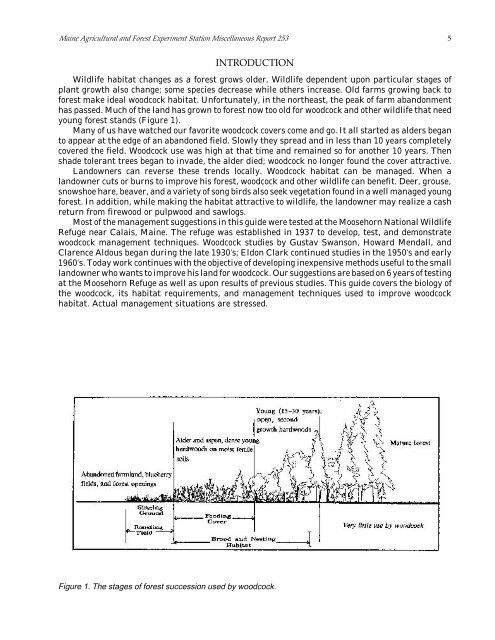A Landowner's Guide to Woodcock Management in the
A Landowner's Guide to Woodcock Management in the
A Landowner's Guide to Woodcock Management in the
You also want an ePaper? Increase the reach of your titles
YUMPU automatically turns print PDFs into web optimized ePapers that Google loves.
Ma<strong>in</strong>e Agricultural and Forest Experiment Station Miscellaneous Report 253<br />
5<br />
INTRODUCTION<br />
Wildlife habitat changes as a forest grows older. Wildlife dependent upon particular stages of<br />
plant growth also change; some species decrease while o<strong>the</strong>rs <strong>in</strong>crease. Old farms grow<strong>in</strong>g back <strong>to</strong><br />
forest make ideal woodcock habitat. Unfortunately, <strong>in</strong> <strong>the</strong> nor<strong>the</strong>ast, <strong>the</strong> peak of farm abandonment<br />
has passed. Much of <strong>the</strong> land has grown <strong>to</strong> forest now <strong>to</strong>o old for woodcock and o<strong>the</strong>r wildlife that need<br />
young forest stands (Figure 1).<br />
Many of us have watched our favorite woodcock covers come and go. It all started as alders began<br />
<strong>to</strong> appear at <strong>the</strong> edge of an abandoned field. Slowly <strong>the</strong>y spread and <strong>in</strong> less than 10 years completely<br />
covered <strong>the</strong> field. <strong>Woodcock</strong> use was high at that time and rema<strong>in</strong>ed so for ano<strong>the</strong>r 10 years. Then<br />
shade <strong>to</strong>lerant trees began <strong>to</strong> <strong>in</strong>vade, <strong>the</strong> alder died; woodcock no longer found <strong>the</strong> cover attractive.<br />
Landowners can reverse <strong>the</strong>se trends locally. <strong>Woodcock</strong> habitat can be managed. When a<br />
landowner cuts or burns <strong>to</strong> improve his forest, woodcock and o<strong>the</strong>r wildlife can benefit. Deer, grouse,<br />
snowshoe hare, beaver, and a variety of song birds also seek vegetation found <strong>in</strong> a well managed young<br />
forest. In addition, while mak<strong>in</strong>g <strong>the</strong> habitat attractive <strong>to</strong> wildlife, <strong>the</strong> landowner may realize a cash<br />
return from firewood or pulpwood and sawlogs.<br />
Most of <strong>the</strong> management suggestions <strong>in</strong> this guide were tested at <strong>the</strong> Moosehorn National Wildlife<br />
Refuge near Calais, Ma<strong>in</strong>e. The refuge was established <strong>in</strong> 1937 <strong>to</strong> develop, test, and demonstrate<br />
woodcock management techniques. <strong>Woodcock</strong> studies by Gustav Swanson, Howard Mendall, and<br />
Clarence Aldous began dur<strong>in</strong>g <strong>the</strong> late 1930’s; Eldon Clark cont<strong>in</strong>ued studies <strong>in</strong> <strong>the</strong> 1950’s and early<br />
1960’s. Today work cont<strong>in</strong>ues with <strong>the</strong> objective of develop<strong>in</strong>g <strong>in</strong>expensive methods useful <strong>to</strong> <strong>the</strong> small<br />
landowner who wants <strong>to</strong> improve his land for woodcock. Our suggestions are based on 6 years of test<strong>in</strong>g<br />
at <strong>the</strong> Moosehorn Refuge as well as upon results of previous studies. This guide covers <strong>the</strong> biology of<br />
<strong>the</strong> woodcock, its habitat requirements, and management techniques used <strong>to</strong> improve woodcock<br />
habitat. Actual management situations are stressed.<br />
Figure 1. The stages of forest succession used by woodcock.

















